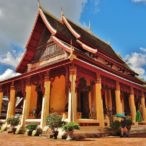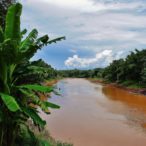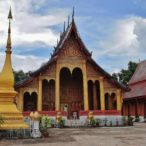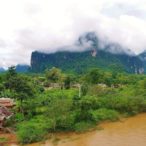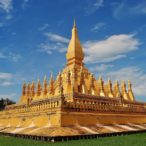Laos
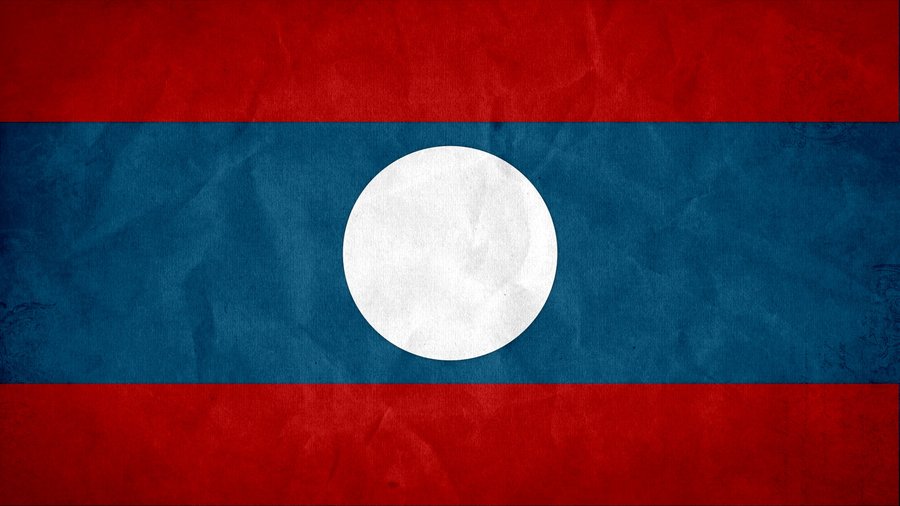
Official name: Lao People’s Democratic Republic
Population: 7 000 000
Area: 237 955 km²

Gallery

In Laos, a communist flag with hammer and sickle on red background is also often used .
Tourist attractions of Laos, Laos – the present times, history of Laos.
Tourist attractions of Laos
Before I came to Laos, I was told to not to expect such great monuments as the Taj Mahal in India, or the temples of Angkor Wat in Cambodia, but I would be delighted by the environment and hospitality of Lao people.
Laos is dominated by mountains and rivers and it is primarily Mekong and its basins. Vast areas of Laos are covered by a jungle untouched by a man, and inside them there are most beautiful waterfalls in this part of Asia. In addition to beautiful waterfalls with turquoise waters, Laos has also deep caves, a land of a thousand lakes, and many interesting Buddhist temples with monks living in them. The great attraction of Laos are the ruins of ancient temples in Champasak, which resemble the style of Angkor Wat in Cambodia. However I most enjoyed exploring deep caves and waterfalls, which from often jumped into cold river. One of the most interesting was Kong Lo cave, and many other beautiful and adventurous ones, close to the village of Vang Vieng. Cruise on the Mekong river is also very popular, as well as the “Pearl of the Orient” – the town of Luang Prabang. However, the clear advantage of Laos is its natural beauty but also good food and culture of hospitality the Lao people. Laos is one of those countries (in contrast to the noisy Thailand) where you can still hide in a quiet village by Mekong, dip yourself in a rice field near buffaloes, and forget that time even exists. A major culture shock is definitely a visit to one of the mountain villages hidden in the jungle, where time had stopped 100 years ago.
I definitely recommend Laos and I think that nobody would be let down by its charms.
Laos – the present times
Economy:
Laos is one of the poorest and most slowly developing countries of South East Asia, which to a big degree depends on foreign aid. Laos is also a communist country, which is in a process of transition from centrally controlled economy to free market economy, but in this instance it doesn’t mean full freedom. Politically Laos copies Vietnam in its one party system, although Lao economy is in my point view owned by Thailand in 70%. Laos is based mainly on trade with neighbouring countries, like for example: Thailand, Vietnam and China. As for today Laos still depends on farming, which employs 80% of the population. Unfortunately in a country close to the total area of Great Britain, only 4% of the land is arable, about of which only 0,34% are permanent fields. Most of Lao fields are used for growing rice, and as it`s been calculated 77% of the population is self-sufficient when it comes to rice. Whilst travelling around Laos it is easy to notice that in lowlands practically every family has a rice field, what explains the above 77% very well. On the other hand growing different kinds of rice in different quantities has a cultural background in Laos. It`s been calculated that Laos has probably the biggest variety of rice in the whole of the Mekong area. Laos is also rich in natural resources and is trying to attract foreign investors to mine coal, bauxite, tin, gold and other precious metals. Unfortunately in Laos there are no investors and there is no money to start mining those resources. Metallurgy and hydroelectricity are also an important part Laos`income, and they are exported mainly to Thailand and Vietnam.
However the fastest growing industry is a tourist industry. Every year Laos is visited by more and more people from all over the world. Laos is very popular because of relaxing and quiet way of life, and the country`s tourist slogan is “Simply beautiful”, what I definitely agree with. Regardless of that beauty, wages in Laos are still very low, which is about $50-$100 a month, and many people live of what they grow and breed by themselves.
Taking into account a total area of Laos, close to the area of Great Britain, the population is about 6,5m people, what includes Laos to the least populated countries of the world, which also has the youngest population of all Asian countries. Small population lives in bigger cities like Vientiane and Luang Prabang, and majority lives in small and very picturesque villages in mountains and close to rivers, although as for Lao conditions even big cities look like bigger, quiet villages.
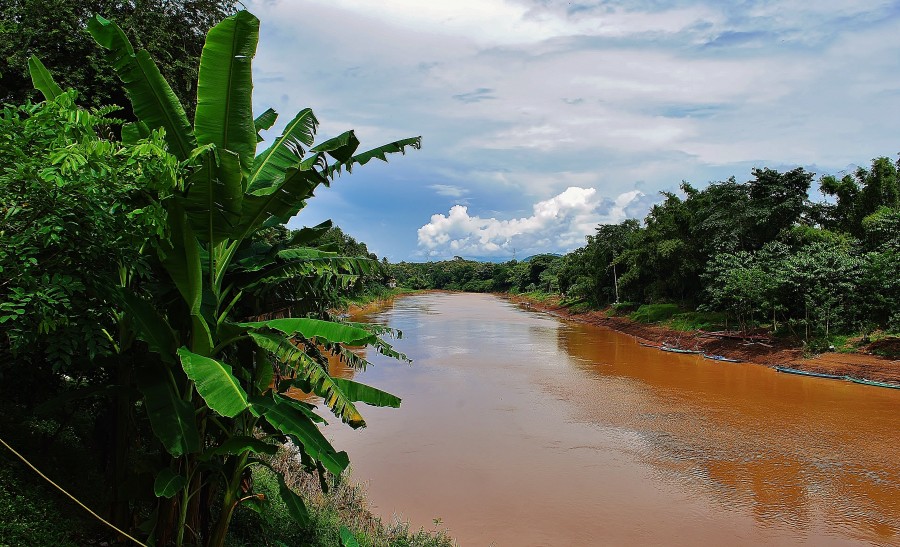
Mekong River. Laos.
Education:
Literacy in Laos stands at a level of 73%. The problem in Laos is that there are 49 different ethnic groups, and many of them have their own languages and cannot speak the national language. Children from those minorities are not able to learn anything at school. It has been calculated that about 23% of Lao people do not go to school at all, and girls who are neglected the most are 25% of all school children. Education in Laos is heavily dependent on subsidies from outside, what for example helps printing more and more books. On the other hand however, they do not get to many people due poor distribution and a low degree of literacy.
Health:
An average life expectancy in Laos is 60-65 years, although an average life expectancy in health is about 55 years. Responsibility for it takes a lack of sanitation, although the situation has improved anyway. In 1990s only 8% of rural Lao population (great majority) had access to sanitation, and in 2010 40%, what is still tragic. However the Lao government still spends only symbolic amounts on health. Laos is a country with a high risk of tuberculosis, and has a number of tropical diseases such as malaria. When it comes to HIV / AIDS Laos is not a country of high risk, but infections are rising mainly due to drug use and homosexuality, but also because of prostitution and extramarital sex.
Culture/Religion:
The main religion is Buddhism (67%), and this religion has great reflection in the culture of Laos, although other religions like for example animalism are also practiced. There are a lot of ethnic groups in Laos and the main language is Laotian, which is similar to Thai, but in the north of the country close the border with China also Chinese is used. In Laos there are 49 different ethnic groups, many of which have their own language, and only 50% can speak the official language.It is also interesting, that polygamy is forbidden in Laos, but in certain ethnic minorities as for example Hmong it still takes place. The main sport of Laos is a type of kick-boxing called Muay-Lao, although football has been recently more and more popular.
Media:
All newspapers in Laos, including the English ones, are published by the government what tells us a lot about freedom of speech in this communist country. On press freedom index Laos is on 165 place, what translates into an absolute censorship.
Environmental problems:
Unfortunately in my point of view the biggest problem is in greed, which is reflected a lack of respect to the natural beauty. Forests and the Mekong river are the biggest richness of Laos, what looks to me that the Lao government does not respect, blindly chasing money. In 1992 48% of Laos was covered by forests, and official data from 2010 show that now it is only 41%, but in reality it is only 35%. (By the way, illegal logging in neigbouring Cambodia is even more horrifying). Especially illegal logging is the biggest problem of all, and for example to neighbouring Vietnam Mekong river flows from Laos about 0,5m m3 of trees every year. (In Laos cut trees are kept on water). Not so long ago the Lao government had a satanic idea. They want to build a huge dam on Mekong. Vietnam has warned already, that 20m people in Vietnam`s Mekong Delta depend on the river, especially that Mekong waters 50% of Vietnamese rice fields, and guarantees fishing and watering fruit. Vietnamese predicted that if the situation doesn’t get better, soon Mekong which provides life also to Laos, will stop providing fish and will become an empty river used only for transportation. On the other hand ignorant Vietnam forgets about their own ecological crimes.

The Mekong River is the centre of the social and cultural life of the people of Laos. It was thanks to this river that trade, Lao people, transport and tourism have developed.
Summary:
I’ve been twice to Laos, in 2004 and in 2011, and I have admit that a lot of things have been improved in the space of 7 years. I think that if Laos continues its free market economy and invests in protecting natural beauty and health, it has good future. When it comes to tourism Laos has a shining future, but on a condition that it doesn’t build architectural garbage spoiling beautiful landscapes.
History of Laos
The first records about the creation of Laos comes from about 2000 BC. These areas were inhabited by hunters, who later began to grow rice. Laos was also more influenced by Indian culture than the Chinese, and Buddhism Indian was introduced to Laos by Indian traders in the first century of our era. From the IX to the XIII century the Khmer Empire controlled the area of the current Laos, and also at that time they built the temple of Wat Pho in Champasak. In the XIV century Laos had two good kings, who developed the country and founded the kingdom of Lan Xang, which in the XVI century begun to weaken due to invasions by Burma. In the XVIII and XIX centuries, Laos was divided into three territories, with centers in Luang Prabang, Vientiane and Pakse, and they suffered because of invasion and occupation by the Siamese (Thailand).
Laos was a French colony from 1893 until World War II, when French Indochina was briefly occupied by Japan during the same time. After war, Laos was again under French rule, but only until 1954 because Laotian nationalists called Pathet Lao joined forces with the communists fighting for the independence of Vietnam, and because that their fight was a success, the French were forced to return Laos its independence. The victory however was not complete because of the US-Vietnam war, and Laos despite its neutrality was drawn into the conflict in the mid 60s because the Vietnamese were using Laos as a transport route of soldiers and weapons (Ho Chi Minh trail). Because of that Americans dropped more bombs on Laos than during the whole of the Second World War. In 1973 when the fighting was over, Laos was prone to what was happening in neighbouring Vietnam.
Then in 1975, because of strong influence from Vietnam led by the communist organization of Pathet Lao, was created the first Lao government and the first leader of Laos was also half Vietnamese. Many were not satisfied with the victory of the communists, and that`s why a lot of people fled to the United States and to neighboring Thailand. Today Laos is a communist country, which in the 90’s trying to save the economy resigned from centrally directed economy. Laos is still a poor country, which is growing in a steady pace.
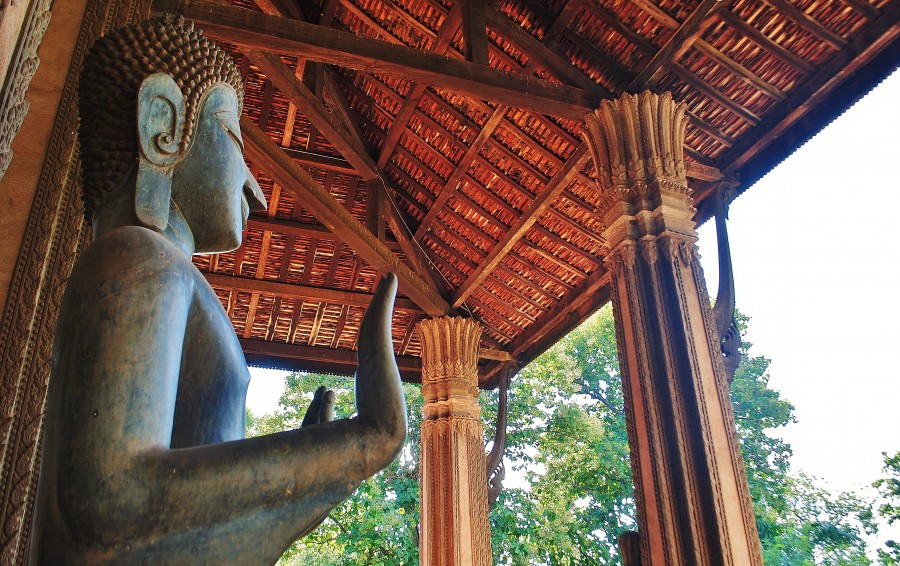
Buddha inside a Buddhist temple in Laos.
Map
Locations
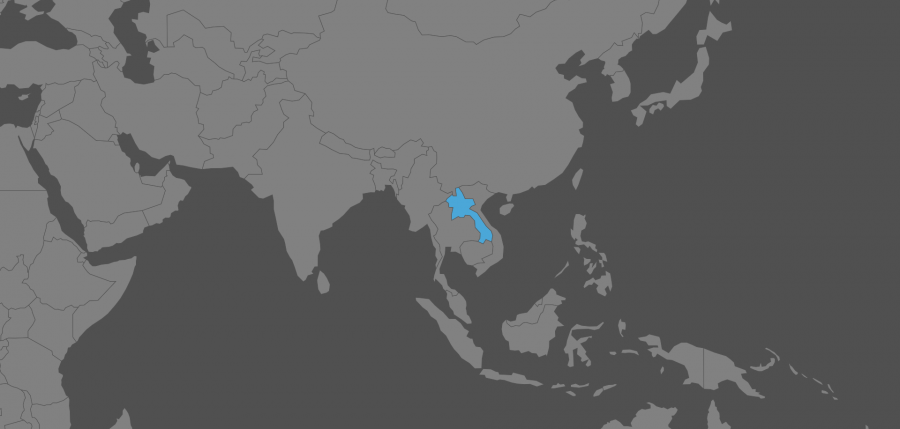
Practical information
Tourist Visa: I got mine in Bangkok although there is no need to get this visa in advance. At all border crossings 1 month tourist visas can be purchased for $30. It can be extended and you can overstay your 30 days, but the penalties and fees are too high to be worth overstaying. (Laos is poor but its visa sticker is pretty impressive).
I recommend Vientiane as a good place to get visas to neighbouring countries, especially to Thailand.
Safety: safe country for tourists. The only danger could be your own stupidity, like drinking to the point that your wallet gets out of your hands, to the pockets of the locals. The worst risk however, is when buying and using even soft drugs (grass etc) because you can often buy it from plain clothed police. Then just one joint can cost $500 in penalties.
Getting around the country: by the standards of a developing country, transportation is pretty good. Condition of the roads between major cities is satisfactory but in the rainy season the only viable means of transportation will be by boat on the Mekong River. Especially in Laos it is a great adventure and I do recommend it. Buses take longer than my patience can handle, but there are minibuses on all tourist trails, which I recommend.
Prices: (in 2011 when $ 1 = 8000 kip): For rooms I paid on average $4 – $6 but it can also be much more expensive. Several times I paid only $2 per night and it was quite good. Transport is expensive and for example for a ride from Vang Vieng to Vientiane I paid 50 000 kip, and for transport transport from Huai Xai to Luang Namtha I paid 100000kip. In the southern parts of Laos a 2-3h ride costs about 30,000 kip. Motorbike hire ranges from $5 – $10 per day depending on location. Fried rice with chicken is an average of $2, the famous BeerLao costs $1.5 and a can of coke $0.5. Apart from that there are numerous snacks and entries to the places of interest, but I think that $20 – $25 a day is sufficient. Unfortunately, products such as chocolates and ice cream are two times more expensive than in neighboring Thailand because they are imported.
Climate: tropical monsoon. There are two seasons: wet (May to October) and dry (November to April). Dividing the months into summer and winter, in the north the temperatures range from 16°C to 28oC and in the south from 23oC to 30oC. In Laos, there are also heavy rainfalls which cause floods.



